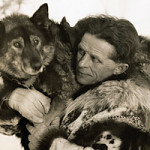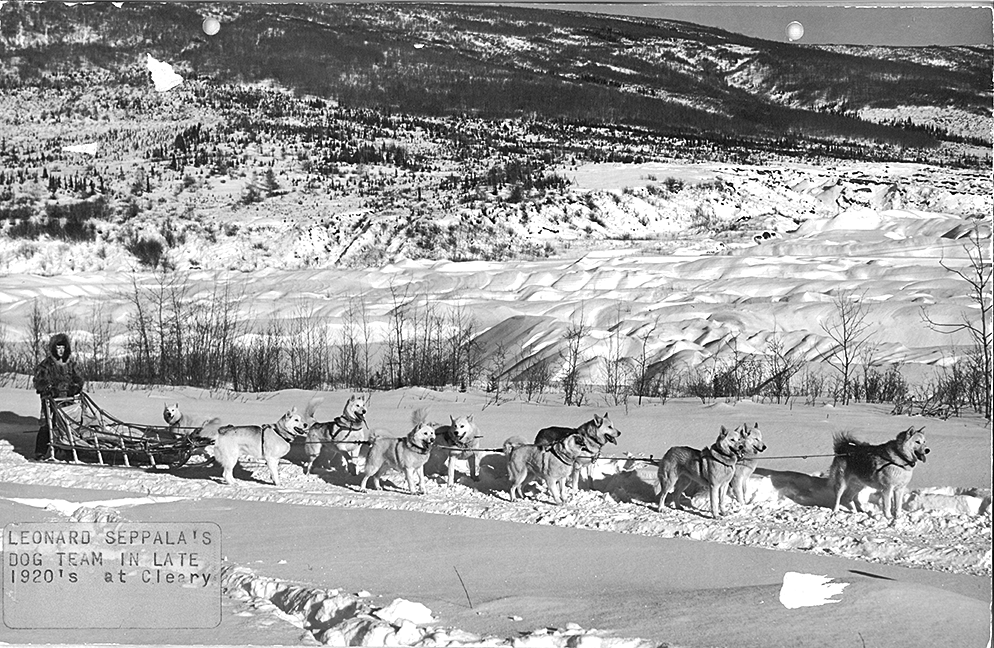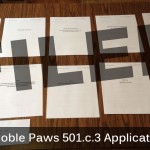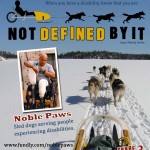I was given this photo (above) from my good friend, and Noble Paws board member, Tracy. Her brother had gotten it from the Anchorage Museum. The museum was clearing out some of their archives and basically had a garage sale full of items they no longer needed.
It’s a picture of Leonhard Seppala’s dog team. If you know who I am talking about then you probably just went, “Oh my”. If you don’t know who Seppala is, just hold on, I will explain more in a moment.
If you look close at the photo you can see a couple tears in it as well as two holes punched in the top of it. Apparently it was in some type of page-flip display while at the museum. But the damage doesn’t bother me. I may do some restoration to it later. But for now, I have it framed and hanging on my wall. It is just such a wonderful gift. I can’t believe it is hanging in my home.
So, I have questions about the picture and I am hoping some of you can help me with the detective work. But first, for those who are going, “Who is Leonhard Seppala?”, let me give you a quick over view of why Alaskans – and dog mushers in particular – have such high regard for Leonhard Seppala.
The Great Serum Run – Leonhard Sepalla and Togo
In January, 1925, diphtheria broke out in Nome, Alaska. Four children had died; an addition 20 had confirmed cases and another 50 more were at risk. Nome was on the verge of an epidemic. Dr. Curtis Welch was the only doctor in Nome. He sent an emergency telegraph declaring they were in urgent need of one million units of diphtheria antitoxin.
Nome is located on the coast of Norton Sound. There were no roads going to Nome. There were only three airplanes in all of Alaska and they were dismantled for the winter. And the train only went from Anchorage to Fairbanks. Its closest point of delivery was in Nenana, over 650 miles away from Nome. To top it off, it was one of the coldest winters in 20 years. Temperatures ranged from -30F to -50F. And daylight visited for only a few hours each day.
So, it was determined the only way to get the serum to Nome would be by dog team. The serum would go by train from Anchorage to Nenana. From there a team of 20 mushers and over 150 dogs would stage themselves across the Alaskan interior and relay the serum 675 miles to Nome. And with that, the Great Serum Run had begun.
The Serum Run turned many sled dogs and their mushers into legends. Many people have heard of the dog Balto, who became famous because the serum run. But Seppala and his lead dog Togo accomplished an arguably more heroic feat than anyone else.
Seppala’s 91 mile leg of the relay, twice as long as any other team, included a risky crossing of Norton Sound in blizzard conditions. It was nighttime when they reached Cap Denbigh on the shore of Norton Sound. Before them laid 20 miles of frozen sea. The nighttime storm made it impossible to see where they were going. And the gale force winds muffled any warning sounds the ice may have given before cracking. But going around the bay would take a full extra day. Nome didn’t have the time to spare. Seppala and Togo were going to cross it.
Between the cold temperature (-85F wind chill), the noise of the storm and the utter darkness, it is hard to imagine the mindset of both man and dog as they crossed the ice. I would think at one point during the three hour crossing Seppala had to visualize the reality of his situation – in the middle of sea ice, 10 miles from any shore, not knowing for sure if he was heading in the right direction, or if the ice was about to crack, or even if the ice had broken off and they were adrift at sea. Sepalla obviously had complete confidence in his lead dog Togo. And rightly so, because Togo avoided cracks and open water and led them safely to the other shore.
 I never had a better dog than Togo. His stamina, loyalty and intelligence could not be improved upon. Togo was the best dog that ever traveled the Alaska trail.
I never had a better dog than Togo. His stamina, loyalty and intelligence could not be improved upon. Togo was the best dog that ever traveled the Alaska trail.
After crossing the sound, Seppala’s team arrived in Golovin (78 miles from Nome) where they handed the serum off to the next musher. The serum arrived in Nome the next day. Not one vial was broken. And Nome was saved from a deadly diphtheria epidemic.
So now you know a little about Leonhard Seppala. It really is an incredible story.
The Seppala Photo
Now, back to the picture. Here is what I know:
- The tag on the photo says it was taken in the late 20’s. So this was after the Serum Run.
- Togo is not in the picture. Togo was darker than those pictured. He had a distinctive chunk taken out of his right ear and he was rather small in build. Togo was in Maine in 1927, where he spent his retirement with a friend of Seppala’s.
- Leonhard is not in the picture either.
Seppala Dog Team Photograph Details
Here are my questions:
- Where is this taken? The museum label says it was taken at “Cleary”. Where is Cleary, Alaska? Or do they mean Cleary Summit (about 20 miles north of Fairbanks)? This would make sense since Seppala moved to the Fairbanks area in 1928.
- Who is the woman? Could this be his wife Constance? I am guessing, yes. (Also, notice the dog behind the sled? Wonder why he got put there. Not sure we will ever know. Maybe he was misbehaving, or injured…)
- Any idea about the lead dog? In 1932 Seppala competed in the dog mushing “demonstration” event at the Lake Placid Winter Olympics. He got a silver medal. Wonder if any of these dogs were there?
- Who is taking the picture? You can see the foot prints from the person taking the picture. I am assuming is it Seppala? But maybe it is a visiting journalist. It’s a pretty clear picture. How skilled did you have to be then to take good photographs? Was Seppala a photographer?
Some interesting trivia I learned while researching the Serum Run.
- Seppala was 47 years old when he participated in the Serum Run.
- Seppala was a small man. He was only 5’4”.
- Seppala is credited with helping establish the AKC recognition of the “Siberian Husky”.






